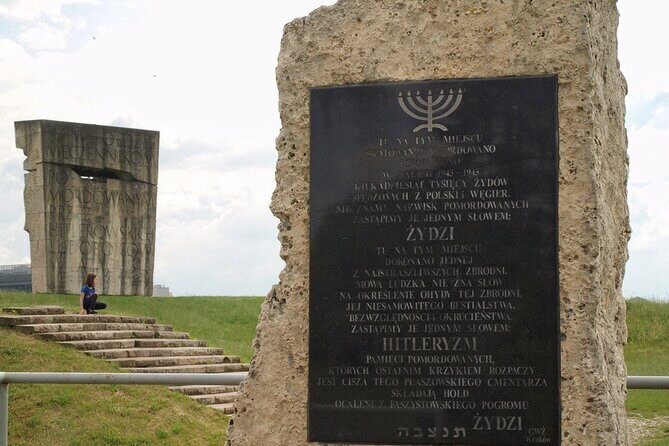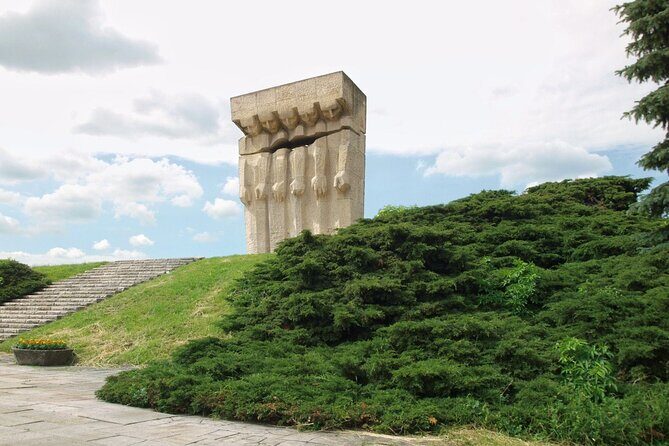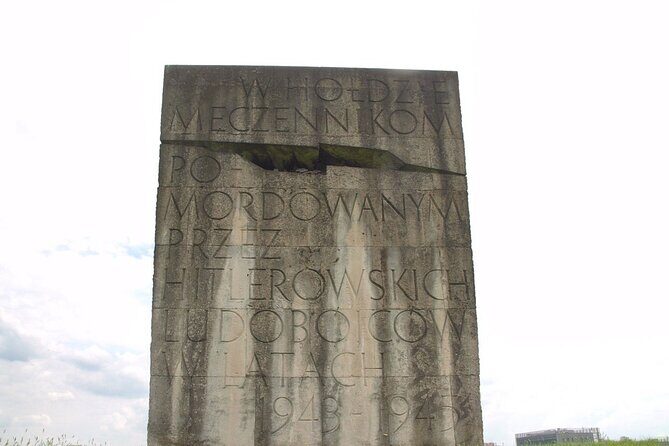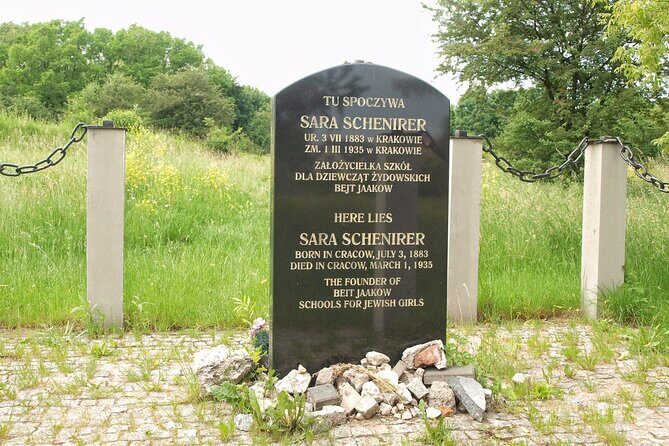Krakow: Former Concentration Camp Plaszow Guided Tour
If you’re visiting Krakow and want to understand its darker chapters, this guided tour offers a meaningful visit to the former Plaszow concentration camp. For just over $23, you’ll spend about two hours exploring a site that played a significant role during WWII, with a knowledgeable guide walking you through its history and current memorials. The experience isn’t just about ticking off a historical site; it’s about confronting difficult truths and honoring the victims in an authentic, respectful way.
What we love most about this tour is how it makes you feel connected to the history through close-up visits to the actual camp grounds and memorials. The guide’s insights add depth to what might otherwise be a stark and sobering experience. Also, the inclusion of the original ghetto wall segment offers a tangible link to the Jewish community that once thrived here, making the history even more personal.
A possible consideration is that the tour involves walking through uneven terrain in the camp area, so moderate physical fitness is recommended. If you’re expecting a very long or in-depth exploration like Auschwitz, keep in mind this is a shorter, more focused visit—perfect for those with limited time or looking for a poignant side of Krakow’s WWII history.
This tour suits travelers who want to go beyond the well-trodden tourist spots and experience a site that’s less commercialized but deeply significant. It’s especially fitting if you’re interested in understanding Krakow’s complex past from a local perspective, guided by someone who can tell stories behind the stones.
Key Points

- Authentic Experience: You visit the actual site of the former Plaszow camp, not just a museum or a replica.
- Expert Guide: Knowledgeable guides, like Kinga, make the history come alive and provide context you won’t find in guidebooks.
- Memorial Focus: The tour includes visits to the large memorial and smaller ones, emphasizing remembrance and respect.
- Accessible and Practical: The tour runs about two hours, with a mobile ticket, and is suitable for most travelers with moderate fitness.
- Historical Significance: The tour covers the camp’s origins, its role during WWII, and the Jewish ghetto wall, providing a well-rounded picture.
- Value for Cost: At just over $23, the tour offers a meaningful, guided walk through a complex history, making it a good value.
A Detailed Look at the Tour

Appreciate having local insight? Here are other guided experiences in Krakow we've examined
Starting Point and Overall Structure
The tour begins at Plac Bohaterów Getta (Ghetto Heroes Square), a site that has undergone many transformations since WWII. Today, it features symbolic metal chairs meant to evoke departure and absence, transforming what was once a bustling Jewish ghetto into a poignant memorial. The guide will likely explain the controversy surrounding its recent redesign and what it represents—an important reminder of the community’s suffering.
From there, the tour moves to Plaszow Concentration Camp, a site that many might pass without noticing its significance. Located on the outskirts of Podgórze, this largely untouched area is a stark reminder of the Nazi forced labor system. Despite being in a desirable part of Krakow—near a shopping center and the Krakus Mound—the land remains an open, somewhat wild space filled with history.
The Camp Itself
While Krakow often gets overshadowed by Auschwitz, the Plaszow camp’s history is equally compelling and tragic. Founded in 1940 initially as a forced labor camp, it was expanded in 1941 into a full-fledged concentration camp, with prisoners forced into quarry work and military factory labor. The site is surprisingly accessible; it’s a large, uneven stretch of land that feels more like a neglected park than a former death camp. Yet, it’s precisely this rawness that makes it powerful.
The guide will walk you through the site, pointing out key features and explaining how the camp operated. You will learn about the prisoners’ daily life, the expansion of the camp, and its connection to the wider Nazi system. This grounding in reality helps us understand the scale and brutality of the camp’s operations.
The Ghetto Wall Segment
One of the most tangible remnants of Krakow’s Jewish history is a 12-meter stretch of the original ghetto wall. This small but powerful fragment stands as a stark reminder of the community that was uprooted and suffering under Nazi oppression. Erected in 1983, the memorial plaque in Hebrew and Polish emphasizes the suffering endured there, marking the starting point for many victims’ final journeys to extermination camps.
Walking along this segment, you’ll feel a real connection to the Jewish population that once called this area home. It’s a profound experience, especially when the guide shares stories about the people behind the wall and their fates.
Memorials and Reflection
The tour ends at the large Victims Memorial erected in 1964 and several smaller ones. These sites are integral to understanding how the community and the country have chosen to remember these dark times. The memorials serve as places for reflection and remembrance, grounding the experience in respect for those who suffered.
- Krakow: Zakopane Tour with Chocholow Thermal Pools and Cable Car
- Krakow to Auschwitz Birkenau Guided Tour with Transfer and Ticket
- Krakow to Auschwitz Birkenau Guided Tour with Ticket Hotel Pickup
- Auschwitz-Birkenau Museum and Memorial Guided Tour from Krakow
- Pub Crawl + Unlimited Drinks + VIP entry + Drinking Games & Photographer
- Pub Crawl Krawl Through Krakow
Why This Tour Is a Worthwhile Investment

The value of this tour isn’t just measured in dollars but in the depth of understanding it provides. For a modest price, you gain access to a site that’s often overlooked but is crucial for a nuanced view of Krakow’s wartime history. The guided element ensures that you won’t just walk around aimlessly but will grasp the stories behind what you see.
The tour’s focus on the local perspective—including the site’s post-war history, the memorials, and the story of the Jewish community—adds a layer of authenticity you won’t get from reading alone. The guide’s insights, such as the story of the controversial 2005 renovation of the square, make the experience more engaging and thought-provoking.
The fact that it is booked an average of 57 days in advance suggests it’s popular among those who want a well-organized, meaningful visit. The tour’s size—capped at 25 travelers—ensures a personal experience where questions are welcome, and the guide can tailor the storytelling.
Who Would Benefit Most?
This experience is ideal for travelers interested in history, remembrance, and local stories. It’s perfect if you want more than just a surface-level visit to WWII sites but aren’t looking for a lengthy day trip to Auschwitz. Those with a moderate level of physical fitness will find it manageable, as the terrain can be uneven.
It’s especially suited for visitors who appreciate guided tours, authentic sites, and a respectful approach to sensitive topics. If you’re looking for insight into the Jewish community’s suffering and the local history of Krakow during WWII, this tour will resonate deeply.
The Sum Up
This guided tour to the former Plaszow concentration camp provides a compelling and respectful way to confront history firsthand. It’s a short, focused experience that offers meaningful insight into a lesser-known chapter of Krakow’s past, delivered by a knowledgeable guide who brings the stories to life.
For those interested in understanding the complexity of WWII in Poland, especially for travelers who want a more personal, less touristy perspective, this tour is an excellent choice. The combination of walking through actual historic sites, visiting memorials, and hearing stories that connect the past to the present creates a powerful, memorable experience.
While it may not be as extensive as trips to Auschwitz, this tour’s accessibility, authenticity, and depth make it a valuable addition to any Krakow itinerary. If you’re prepared for some walking and a serious dose of history, you’ll find it well worth the modest price.
FAQ

Is this tour suitable for all ages?
Yes, as long as participants have moderate physical fitness and are comfortable walking through uneven terrain. It’s a respectful and educational experience appropriate for most age groups.
How long does the tour last?
Approximately 2 hours, making it a manageable stop that fits into a busy sightseeing day.
What is included in the tour?
A professional guide leads the walk, sharing detailed stories and context. The ticket is mobile, and the experience starts at Plac Bohaterów Getta.
Do I need to arrange transportation?
Public transportation is nearby, but transportation isn’t included in the price. Make sure to plan your route in advance.
Is the tour suitable for people with limited mobility?
While manageable for most, the uneven terrain at the camp site might be challenging for some with mobility issues.
Can I cancel if I change my mind?
Yes, cancellation is free up to 24 hours in advance for a full refund.
Is this tour connected to Auschwitz?
No, it’s a separate site with a different focus—more on the local history and the camp’s specific role in Krakow’s WWII experience.
How do I book this tour?
You can reserve your spot online through Viator or similar platforms, with tours generally booked well in advance due to popularity.
In short, if you’re looking for a respectful, insightful, and authentic look at a lesser-known but significant WWII site in Krakow, this guided walk through Plaszow hits the mark. It’s a chance to engage with history directly and understand the human stories behind the stones—an experience that stays with you long after the walk ends.
More Guided Tours in Krakow
- From Krakow: Salt Mine Guided Tour with hotel pick up
- From Krakow: Wieliczka Salt Mine Guided Tour
- Auschwitz-Birkenau Guided Tour with Private Transport from Kraków
- Salt Mine Guided Tour from Krakow (hotel pick up)
- Krakow: Private Panoramic Tour by Golf Cart with Audio Guide
- Krakow: Kazimierz, Schindler’s Factory, & Ghetto Guided Tour
More Tours in Krakow
- From Krakow: Salt Mine Guided Tour with hotel pick up
- Krakow: Highlights of Old & New Town Private Walking Tour
- From Krakow: Wieliczka Salt Mine Guided Tour
- Krakow Old Town & Kazimierz Highlights Tour by Electric Car
- From Krakow: Dunajec River Rafting, Cable Car and Castle Niedzica – Day Tour
- 1-Hour Tour to Krakow’s Old Town by Electric Golf Cart
More Tour Reviews in Krakow
- From Krakow: Morskie Oko and Slovakia Treetop Walk
- From Krakow: Salt Mine Guided Tour with hotel pick up
- Krakow: Highlights of Old & New Town Private Walking Tour
- From Krakow: Wieliczka Salt Mine Guided Tour
- Krakow Old Town & Kazimierz Highlights Tour by Electric Car
- From Krakow: Dunajec River Rafting, Cable Car and Castle Niedzica – Day Tour
More Krakow experiences we've covered
- 11 Fantastic Workshops & Classes In Krakow
- 14 Best Wine Tours In Krakow (With Reviews & Prices)
- Which Krakow Walking Tours To Choose? We Rank The 16 Best
- The Top 11 Tours In Krakow
- Top 16 Spa & Hot Springs Experiences In Krakow
- Discover 7 Great Shopping & Market Tours In Krakow
- The 10 Most Popular Private Driver Services In Krakow
- Our Picks For The 5 Best Photography Experiences In Krakow
- Krakow’s 10 Best National Park Tours (With Prices & Reviews)
- Krakow’s 4 Best Motorbike And Scooter Rentals
- Top 7 Massage & Relaxation Services In Krakow
- Krakow’s 16 Best Lunch Experiences: Which To Choose?
